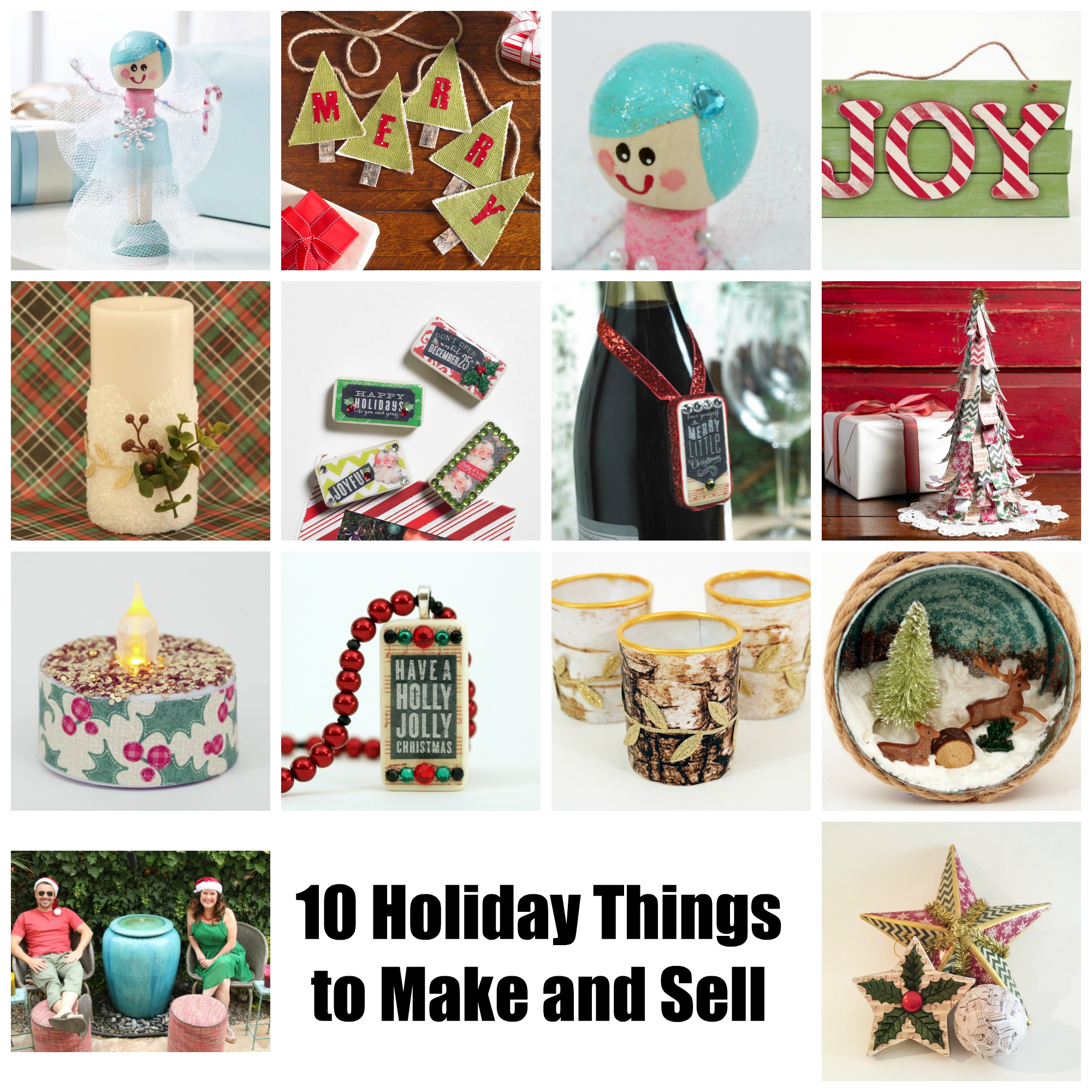DIY crafts you can sell? It’s not just a hobby, it’s a potential goldmine! This guide dives headfirst into the exciting world of transforming creative passion into profitable ventures. We’ll explore lucrative craft niches, sustainable sourcing, savvy pricing strategies, and effective marketing techniques to help you turn your handmade treasures into a thriving business. Get ready to unleash your inner entrepreneur and craft your way to success!
From identifying profitable niches and sourcing materials responsibly to mastering pricing strategies and marketing your creations effectively, we’ll cover every step of the process. We’ll even tackle the less glamorous, but equally important, aspects like legal considerations and business planning. So grab your glue gun, your entrepreneurial spirit, and let’s get crafting!
Profitable DIY Craft Niches
The world of handmade crafts is bursting with potential! But not all niches are created equal. Some offer a sweet spot of high demand and relatively low competition. Let’s dive into three underserved craft niches with serious earning potential, complete with target audience profiles, cost analyses, and profit projections. Get ready to unleash your inner artisan entrepreneur!
Three Underserved Craft Niches with High Sales Potential
We’ve identified three promising niches: personalized pet portraits, upcycled clothing accessories, and custom resin jewelry. Each offers a unique blend of creativity, marketability, and profit potential.
Target Audience and Market Analysis for Each Niche
Understanding your customer is key. Let’s profile the ideal buyer for each niche.
- Personalized Pet Portraits: Target audience includes pet owners (Millennials and Gen X are particularly strong demographics), often with disposable income and a strong emotional connection to their furry friends. They value unique, personalized gifts and cherish memories. Interests include pet care, photography, and home decor.
- Upcycled Clothing Accessories: This niche appeals to environmentally conscious consumers (Gen Z and Millennials), who value sustainability and unique, stylish accessories. They are interested in fashion, upcycling, and eco-friendly products. They often have a strong social media presence and are influenced by trends.
- Custom Resin Jewelry: This niche attracts a broad audience, including fashion-forward individuals (Gen Z and Millennials), who appreciate unique, handmade jewelry. They value artistry, personalization, and the ability to express their individuality. Interests include fashion, art, and self-expression.
Production Costs and Profit Margins Comparison

Let’s crunch some numbers to compare the profitability of each niche. Note that these are estimates and can vary depending on materials, scale, and your specific business model.
| Niche | Target Audience | Startup Costs | Profit Potential |
|---|---|---|---|
| Personalized Pet Portraits | Pet owners (Millennials, Gen X) | $100 – $300 (drawing tablet, software) | High (depending on portrait size and complexity) |
| Upcycled Clothing Accessories | Environmentally conscious consumers (Gen Z, Millennials) | $50 – $150 (sewing machine, basic supplies) | Medium to High (depending on materials and design) |
| Custom Resin Jewelry | Fashion-forward individuals (Gen Z, Millennials) | $150 – $400 (resin, molds, jewelry findings) | Medium to High (depending on design complexity and materials) |
Craft Sourcing and Production
Sustainable sourcing and efficient production are vital for your craft business. Let’s explore ethical material options and streamline your crafting process.
Sustainable Sourcing Options for Craft Materials
Choosing sustainable materials is not only good for the planet, it also resonates with environmentally conscious consumers, boosting your brand image.
- Recycled Materials: Upcycling clothing scraps, repurposing glass jars, and using reclaimed wood are fantastic ways to minimize waste and add a unique touch to your creations.
- Eco-Friendly Suppliers: Many suppliers now offer eco-friendly alternatives, such as organic cotton, recycled paper, and sustainably harvested wood. Research suppliers committed to ethical and sustainable practices.
- Local Sourcing: Supporting local farmers, artisans, and businesses not only reduces your carbon footprint but also fosters community connections and can lead to unique, locally sourced materials.
Production Process for Upcycled Clothing Accessories
Let’s take a closer look at the production of a specific craft item: upcycled denim tote bags.
- Materials: Old jeans (various sizes), sturdy cotton lining fabric, heavy-duty thread, zipper (optional), sewing machine, scissors, measuring tape, pins.
- Step-by-step Production Process:
- Deconstruct old jeans, separating the legs and pockets.
- Cut out tote bag pieces from the denim, allowing for seams.
- Cut lining pieces to match the denim pieces.
- Sew side seams of denim and lining separately.
- Pin denim and lining together, right sides facing.
- Sew around the top edge, leaving a gap for turning.
- Turn the bag right side out through the gap.
- Sew the gap closed.
- Attach zipper (optional).
- Add decorative stitching (optional).
Tools and Equipment Categorization, Diy crafts you can sell
Having the right tools makes all the difference. Here’s a breakdown of essential, helpful, and optional tools for each niche.
- Personalized Pet Portraits: Essential: Drawing tablet, art software. Helpful: High-quality printer, scanner. Optional: Professional editing software.
- Upcycled Clothing Accessories: Essential: Sewing machine, scissors, measuring tape, pins. Helpful: Iron, pressing board. Optional: Overlocker, embroidery machine.
- Custom Resin Jewelry: Essential: Resin, molds, jewelry findings, mixing cups, gloves. Helpful: UV lamp, jewelry pliers. Optional: Resin colorants, glitter, embellishments.
Pricing Strategies for Handmade Goods
Pricing your crafts correctly is crucial for profitability. Let’s explore different pricing models and demonstrate how to calculate your costs.
Different Pricing Models for Handmade Crafts
There are several ways to price your handmade goods, each with its own advantages and disadvantages.
- Cost-Plus Pricing: Calculate your COGS (Cost of Goods Sold) and add a markup percentage to determine your selling price. Simple, but may not account for market demand.
- Value-Based Pricing: Set your price based on the perceived value of your product to the customer. This can lead to higher profit margins but requires careful market research.
- Competitive Pricing: Research prices of similar items from competitors and set your price accordingly. This ensures competitiveness but might limit profit margins.
Calculating Cost of Goods Sold (COGS)
Let’s calculate the COGS for a simple upcycled denim tote bag:
COGS = Material Cost + Labor Cost + Overhead Cost
Example: Material Cost ($5), Labor Cost ($10), Overhead Cost ($2) = COGS of $17
Pricing Strategy Comparison
| Item | Pricing Model | Price |
|---|---|---|
| Upcycled Denim Tote | Cost-Plus (50% markup) | $25.50 |
| Personalized Pet Portrait | Value-Based | $75 – $150 (depending on size and complexity) |
| Custom Resin Earrings | Competitive | $20 (based on market research) |
Marketing and Sales Channels
Getting your crafts in front of potential buyers requires a strategic approach. Let’s explore effective online marketplaces and social media strategies.
Effective Online Marketplaces for Handmade Crafts

Several online platforms are ideal for selling handmade goods. Each offers unique advantages and disadvantages.
- Etsy: A large and established marketplace specifically for handmade and vintage items. Pros: Large audience, built-in customer base. Cons: High fees, significant competition.
- Amazon Handmade: Integrates with Amazon’s vast customer base. Pros: Massive reach, established logistics. Cons: Stricter requirements, higher competition.
- Shopify: Allows you to create your own online store. Pros: Greater control over branding and pricing. Cons: Requires more technical expertise and marketing effort.
Creating Compelling Product Listings
High-quality photos, detailed descriptions, and accurate s are essential for attracting buyers.
- Use professional-looking photos showcasing your craft’s unique features.
- Write detailed descriptions highlighting the benefits and unique selling points.
- Use relevant s to improve search engine optimization ().
Social Media Marketing Strategy for Upcycled Denim Totes
A sample social media strategy for upcycled denim totes:
- Platform: Instagram
- Content: High-quality product photos, behind-the-scenes glimpses of the crafting process, lifestyle shots showcasing the tote’s versatility, customer testimonials.
- Posting Schedule: 3-5 times per week, consistent posting times.
- Hashtags: #upcycledfashion, #denimtote, #sustainablefashion, #handmadewithlove, #ecofriendlybags.
Packaging and Presentation
Packaging is more than just protection; it’s part of the overall brand experience. Let’s explore creative and cost-effective packaging options.
Creative and Cost-Effective Packaging Ideas
Packaging should reflect your brand and protect your crafts while enhancing their presentation.
- Recycled Cardboard Boxes: Eco-friendly and readily available, these can be customized with stickers or stamps.
- Fabric Bags: Reusable and stylish, fabric bags add a touch of elegance and reinforce your brand’s commitment to sustainability.
- Kraft Paper Envelopes: Simple, elegant, and cost-effective, these are perfect for smaller items like jewelry or prints.
Importance of Branding and its Impact on Sales
A strong brand builds trust and loyalty. Your brand should communicate your values, style, and unique selling proposition.
Creating Visually Appealing Product Photography
High-quality product photos are essential for showcasing your crafts. Use good lighting, a clean background, and consider styling your products to highlight their features.
Product Descriptions Highlighting Unique Selling Points
Here are descriptions for three different craft items:
Upcycled Denim Tote: This stylish tote bag is made from recycled denim, giving it a unique character and reducing textile waste. Its durable construction makes it perfect for everyday use, while its unique design makes it a statement piece.
Personalized Pet Portrait: Capture the unique personality of your beloved pet with a custom portrait. Our skilled artists create stunning, personalized artwork that will be cherished for years to come. Available in various sizes and styles.
Custom Resin Earrings: These unique resin earrings are handcrafted with high-quality materials and stunning designs. Each pair is one-of-a-kind, adding a touch of elegance and individuality to your style.
Legal and Business Aspects: Diy Crafts You Can Sell
Before you start selling, it’s crucial to understand the legal and business aspects of running a craft business.
Essential Legal Considerations for Selling Handmade Crafts
Understanding the legal requirements for your craft business is vital to avoid potential problems.
- Business Licenses and Permits: Check with your local authorities to determine the necessary licenses and permits for operating your business.
- Intellectual Property Protection: If you have unique designs, consider registering your trademarks or copyrights to protect your creations.
- Sales Tax Compliance: Understand and comply with sales tax regulations in your area.
Importance of Proper Record-Keeping for Business Finances
Maintaining accurate financial records is essential for tracking income, expenses, and profitability. This also simplifies tax preparation and helps you make informed business decisions.
Handling Customer Inquiries and Returns/Refunds
Providing excellent customer service is crucial for building a positive reputation. Establish clear policies for handling customer inquiries, returns, and refunds.
Simple Business Plan Artikel
- Market Analysis: Identify your target audience, competition, and market trends.
- Sales Strategy: Artikel your sales channels, pricing strategy, and marketing plan.
- Financial Projections: Develop a financial forecast including startup costs, projected revenue, and expenses.
So there you have it – a comprehensive roadmap to turning your DIY passion into a profitable business. Remember, success isn’t just about creating beautiful crafts; it’s about understanding your market, pricing strategically, and marketing effectively. With a little planning, creativity, and hustle, you can transform your handmade dreams into a thriving reality. Now go forth and craft your empire!
FAQ Explained
What are some low-cost marketing strategies?
Leverage free social media platforms like Instagram and Pinterest. Create visually appealing content and engage with your audience. Participate in online craft communities and forums.
How do I handle customer returns?
Establish a clear return policy upfront. Be professional and understanding when handling returns. Offer refunds or exchanges as appropriate, depending on the situation and your policy.
What legal considerations should I be aware of?
Check local regulations regarding business licenses and permits. Understand copyright and intellectual property laws. Ensure your product descriptions are accurate and truthful to avoid misleading customers.
Notice how to make homemade crafts for recommendations and other broad suggestions.
How can I protect my designs from being copied?
Watermarking your images can deter some copying. Registering your designs with a copyright office provides legal protection. Consider using unique design elements that are difficult to replicate.


